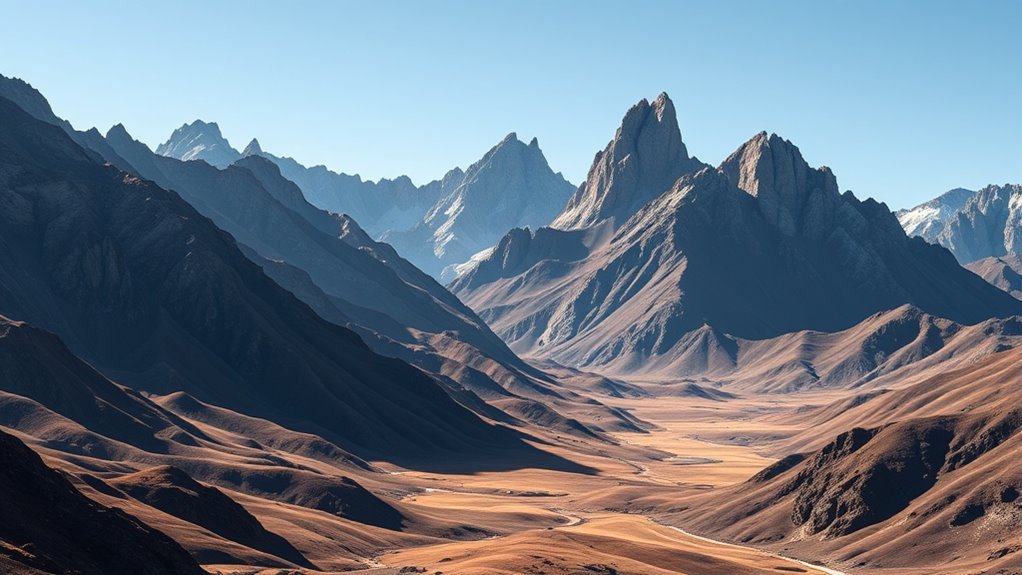Geographic features greatly influence squall formation and strength. Topography, such as mountains, creates orographic lifting, enhancing precipitation on windward sides while leaving leeward areas drier. Valleys contribute to unique microclimates through temperature differentials and wind channeling. Coastal regions benefit from moisture supplied by the ocean, intensifying squalls when warm waters are involved. Urban areas further boost convection processes, affecting squall intensity. Understanding these interactions provides essential observations into localized weather patterns. More findings can be uncovered on this topic.
Main Points
- Topography significantly affects squall intensity and movement by creating localized weather patterns through the interaction of warm and cool air masses.
- Orographic lifting in mountainous regions leads to increased precipitation on the windward side, enhancing squall strength and frequency.
- Valleys create distinct microclimates, influencing temperature and humidity levels that can amplify squall activity during weather events.
- Coastal regions experience squalls due to warm ocean waters providing moisture, which is essential for precipitation during such events.
- Urban landscapes can intensify squalls through the urban heat island effect and wind channeling, altering local airflow patterns and humidity levels.
The Role of Topography in Squall Development
Topography plays an essential role in the development of squalls, influencing their intensity and movement. Variations in terrain, such as valleys, hills, and plains, can create localized weather patterns that improve squall formation. When warm, moist air encounters cooler air over diverse terrains, it can lead to the rapid development of convective cells, which are vital for squall creation.
In flatter regions, squalls may travel more uniformly, while irregular topography can disrupt airflow, causing squalls to intensify or change direction unpredictably. The presence of bodies of water can also contribute by adding moisture to the atmosphere, further fueling squall activity.
Ultimately, the interplay between topographic features and atmospheric conditions is important in determining the characteristics of squalls, including their strength and the potential for severe weather events.
Understanding these dynamics helps meteorologists predict squall behavior with greater accuracy.
How Mountains Affect Wind Patterns

Mountains greatly influence wind patterns through several mechanisms.
The orographic lifting effect causes air to rise and cool, leading to precipitation on the windward side, while the formation of wind shadows results in drier conditions on the leeward side.
Additionally, temperature inversions can occur in mountainous regions, affecting local weather and contributing to squall development.
Orographic Lifting Effect
As air encounters raised terrain, it is forced to rise, leading to a phenomenon known as orographic lifting. This process occurs when prevailing winds hit mountain ranges, causing the air to ascend.
As the air rises, it cools and expands, resulting in condensation and the formation of clouds. This can lead to notable precipitation on the windward side of the mountains.
The orographic lifting effect plays an essential role in weather patterns, particularly in regions where mountains are prominent. It can improve squall formation by increasing moisture availability and instability in the atmosphere.
Consequently, the interplay between mountains and wind patterns can greatly influence local climate and weather events, particularly during intense storm systems.
Wind Shadow Formation
Wind shadows create distinct climatic zones that greatly impact local weather patterns. When winds encounter mountain ranges, they are forced to ascend, leading to orographic lifting and precipitation on the windward side.
As air descends on the leeward side, it undergoes adiabatic warming, resulting in drier conditions. This phenomenon creates a wind shadow, where vegetation and moisture levels differ markedly compared to adjacent areas.
The altered wind patterns can lead to reduced squall activity in the rain shadow regions, as the lack of moisture inhibits storm development.
In addition, these wind shadows can influence local ecosystems, often creating arid terrains juxtaposed against lush environments on the windward slopes.
Understanding this dynamic is essential for predicting localized weather events.
Temperature Inversion Impact
Although temperature inversions typically occur in valleys or low-lying areas, their effects can be greatly influenced by surrounding mountain ranges.
Mountains can trap cooler air in valleys, creating a stable layer that inhibits vertical mixing. This can lead to the accumulation of moisture and pollutants, which may improve squall formation under certain conditions.
Additionally, the topography can alter wind patterns, leading to localized areas of increased uplift, essential for developing strong squalls.
- Air stagnation: Inversions trap air, preventing dispersion.
- Increased moisture: Accumulation of humidity can fuel squalls.
- Altered wind patterns: Mountains redirect airflow, influencing squall dynamics.
The Impact of Valleys on Microclimates

Valleys play an essential role in shaping microclimates due to their unique topographical features and the way they influence local weather patterns. The enclosed nature of valleys often leads to temperature inversions, where warmer air traps cooler air at lower elevations. This can result in distinct temperature differences between the valley floor and surrounding highlands.
Moreover, valleys can collect moisture, creating localized areas of higher humidity, which can influence precipitation patterns.
The orientation of a valley can also affect sunlight exposure, with south-facing slopes typically receiving more sunlight, resulting in warmer conditions compared to north-facing slopes. These variations can support diverse ecosystems within close proximity, as plants and animals adjust to the specific conditions.
In addition, the presence of walls or ridges surrounding a valley can channel winds, impacting airflow and further contributing to the microclimate's uniqueness. Hence, valleys serve as critical zones for understanding localized climatic effects.
Coastal Influences: The Interaction of Land and Sea

The interplay between land and sea creates a dynamic environment that greatly influences local weather patterns and climatic conditions. Coastal regions often experience unique squall formations due to the contrasting thermal properties of land and water. The differential heating leads to the development of sea breezes, which can trigger localized thunderstorms.
Key factors in this interaction include:
- Temperature Gradients: The disparity in temperatures between land and water can create unstable air masses, promoting squall activity.
- Moisture Availability: The ocean serves as a vital source of moisture, which is essential for the development of precipitation during squalls.
- Topographical Influence: Coastal landforms, such as cliffs and bays, can modify wind patterns, further impacting squall intensity and movement.
Understanding these interactions is fundamental for predicting squall behavior and mitigating potential hazards in coastal areas.
Urban Landscapes and Their Effect on Squall Intensity

As urban environments emerge, their unique features can greatly alter squall intensity and behavior. The presence of tall buildings often creates wind tunnels, which can boost wind speeds and potentially modify the direction of squall lines.
Additionally, the heat generated by urban infrastructure contributes to localized temperature increases, known as the urban heat island effect. This phenomenon can amplify convection processes, leading to the formation of more robust squalls.
Urban surfaces, such as concrete and asphalt, tend to absorb and retain heat, affecting local humidity levels. Increased evaporation can supply additional moisture to the atmosphere, which may further fuel squall development.
Furthermore, urban settings may disrupt natural drainage patterns, causing localized flooding during intense squalls. These interactions between urban features and atmospheric conditions illustrate how human-made environments can greatly influence the intensity and characteristics of squalls, underscoring the importance of considering urban geography in meteorological studies.
The Significance of Vegetation and Land Use
The interaction between vegetation and land use plays a vital role in squall formation.
Forest cover can influence local microclimates, while urban heat islands may exacerbate storm intensity.
Additionally, agricultural practices can impact moisture levels and airflow, further affecting squall dynamics.
Impact of Forest Cover
While various factors contribute to squall formation, forest cover plays an essential role in influencing local microclimates and weather patterns. Dense vegetation can modify temperature and humidity levels, creating conditions that either suppress or improve squall activity.
Forests contribute to increased evapotranspiration, which can raise moisture levels in the atmosphere, potentially leading to the formation of convective storms. Additionally, the presence of trees can disrupt wind patterns, affecting how air masses interact and evolve.
- Evapotranspiration: Increases atmospheric moisture, aiding storm development.
- Wind Disruption: Alters air movement, influencing squall strength and direction.
- Temperature Regulation: Modifies localized heat, impacting storm initiation.
Urban Heat Islands
Although urban areas often see considerable temperature increases due to human activities and infrastructure, the presence of vegetation and thoughtful land use can mitigate the effects of urban heat islands (UHIs).
Vegetation, including trees, parks, and green roofs, plays a vital role in cooling urban environments by providing shade and enhancing evapotranspiration. These natural elements can markedly reduce surface and air temperatures, countering the heat generated by concrete and asphalt.
Additionally, strategic land use planning that incorporates green spaces not only improves air quality but also promotes biodiversity.
Urban planners and policymakers are increasingly recognizing the importance of integrating vegetation into urban design as a means to combat UHIs and create more sustainable, livable cities.
Agricultural Practices Effects
Urban vegetation not only mitigates heat effects but also plays an important role in agricultural practices and land use. The presence of vegetation influences local microclimates, which can improve or diminish squall formation.
Agricultural practices, such as crop selection and land management, directly impact soil moisture and temperature, further affecting the dynamics of these weather events.
Key factors include:
- Vegetation cover: Provides shade and reduces surface temperatures, affecting local humidity levels.
- Soil management: Practices like cover cropping improve soil health, influencing local air circulation and moisture retention.
- Land use changes: Urban expansion can disrupt natural environments, altering airflow and potentially increasing squall intensity.
Understanding these interactions is crucial for managing agricultural areas in the context of changing weather patterns.
Case Studies: Geographic Features and Notable Squalls
Geographic features considerably influence the formation and intensity of squalls, as demonstrated by various case studies around the world.
For instance, the Sierra Nevada mountains in California often experience intense squalls due to orographic lifting, which improves precipitation as moist air ascends.
Similarly, the coastal regions of the Gulf of Mexico frequently witness squall lines triggered by the warm waters, creating severe storms that can lead to hazardous weather conditions.
In the Midwest United States, the flat terrain allows for the development of supercell thunderstorms, resulting in squalls that can produce damaging winds and hail.
Additionally, the unique topography of the Appalachian Mountains can channel storm systems, intensifying squall activity in certain valleys.
These examples illustrate how specific geographic features, such as mountains, coastlines, and plains, play a critical role in shaping squall events, emphasizing the need for localized weather prediction models.
Common Questions
How Do Squalls Differ From Thunderstorms in Terms of Formation?
Squalls typically form along cold fronts and can persist for hours, defined by sudden wind shifts. In contrast, thunderstorms arise from localized convection and are often short-lived, focusing on updrafts and electrical activity.
Can Squalls Occur Without Geographic Features?
Squalls can occur independently of geographic features. They often form due to atmospheric conditions like temperature changes and wind shear, demonstrating that while geographic influences can improve squalls, they are not strictly necessary for their formation.
What Role Does Temperature Play in Squall Intensity?
Temperature considerably impacts squall intensity, as warmer air improves instability and moisture availability. This combination can lead to stronger updrafts and more vigorous thunderstorms, eventually increasing the total intensity and duration of squall events.
How Do Seasonal Changes Affect Squall Patterns?
Seasonal changes considerably affect squall patterns, as atmospheric stability varies. In warmer months, increased moisture and temperature can intensify squalls, while colder months may reduce their frequency and strength, altering precipitation dynamics and storm behavior.
Are Squalls More Common in Certain Regions Worldwide?
Squalls occur more frequently in specific regions, particularly where warm and cold air masses interact. Coastal areas and places with notable temperature contrasts, such as the Great Plains, often experience increased squall activity due to these conditions.

